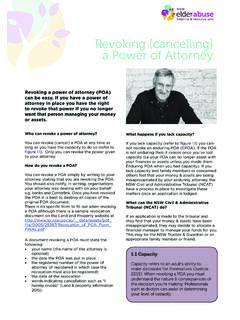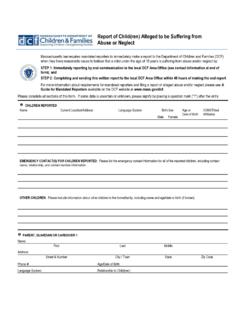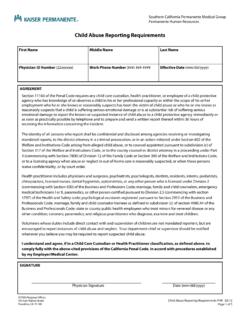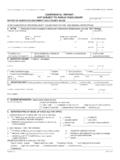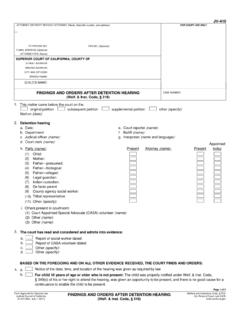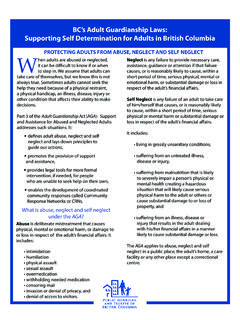Transcription of Preventing and responding to abuse of older people
1 Preventing and responding to abuse of older people NSW interagency policy November 2015. Contents Section 1 Introduction and background .. 3. Developing an interagency policy .. 3. The NSW Government 4. A societal approach .. 5. The wider context .. 5. Governance .. 6. Section 2 Parameters of the policy .. 7. Purpose of policy .. 7. Agency 7. Section 3 Definitions and forms of abuse of older people .. 9. Definitions of abuse .. 9. Forms of abuse of older 9. Section 4 Principles governing responses to abuse of older people living in community settings .. 12. General principle .. 12. Principles for intervention .. 12.
2 Risk factors .. 13. Principles of interagency practice .. 14. Section 5 Key concepts in responding to abuse of older people .. 15. Mental capacity and consent .. 15. Undue influence and consent .. 15. Privacy, confidentiality and sharing information .. 16. Section 6 Roles and responsibilities .. 18. NSW Elder abuse Helpline and Resource Unit .. 18. NSW agencies including NSW Police .. 19. Reporting to NSW Police .. 19. Section 7 Policy review .. 20. Appendix one Charter of Victims Rights .. 21. Appendix two United Nations Principles for older 22. Contact details .. 24. 2 NSW interagency policy I Preventing and responding to abuse of older people 1 Introduction and background Developing an interagency policy The NSW Government first published an abuse of older people : Interagency Protocol and an associated Legal Issues Manual in 1995.
3 The interagency protocol was revised in 2007 to take into account changes over the previous decade in service delivery and in practice, legislation and approaches to victims' rights. The interagency protocol continued to promote a coordinated response to the abuse of older people living in community settings and the need to prioritise the safety and well being of older people who are at risk or have experienced abuse and neglect and the role that service providers have in responding . The review found that the success of an interagency protocol is largely determined by the ability of staff from different agencies around the state to respond with both a common purpose and confidence to different cases of abuse .
4 The subsequent release of the NSW Ageing Strategy in 2012 provided an impetus for establishing a statewide specialist helpline and resource unit to help ensure the policy is effectively implemented and outcomes monitored. The Interagency Committee on responding to Elder abuse recognised the need for a greater focus on interagency cooperation statewide in responding to different forms of abuse . It therefore decided this was best achieved through refining the interagency protocol as a State policy which sets out principles for action to guide the work of the Helpline and Resource Unit and the development of local/regional protocols and practice guidelines at agency level.
5 The NSW Government's commitment to tackling abuse reflects the UN. Principles for older Persons. The United Nations Principles for older Persons' (resolution 46/91) encourages governments to incorporate them into national programmes when ever possible. The principles call for action in many areas, among them: independence, participation, care, self-fulfilment and dignity. These principles are set out in Appendix Two. In addition, UN. Declaration on the Rights of Indigenous Peoples (2007, resolution 61/295). provides that States shall take effective measures to ensure continuing improvement of economic and social conditions, rights and special needs of Indigenous elders (Arts 21(2) and 22(1).)
6 3 NSW interagency policy I Preventing and responding to abuse of older people The NSW Government commitment The NSW Government's vision is for a healthy, vibrant and active ageing population in NSW. It is committed to helping individual citizens take responsibility for their future. The government has developed a NSW Ageing Strategy designed to harness the contribution of seniors and meet the challenges and opportunities of an ageing population now and into the future. The NSW Government's commitment includes responding to the abuse of older people . It has therefore made tackling abuse a priority and recognises that older people will benefit from strategies put in place to help them prevent and end abuse when it occurs.
7 At 30 June 2012 there were million people aged 65 and over living in NSW (14 per cent of the population). It is predicted the number of people aged over 65 years in NSW will double from million people in 2012 to million in 2050 (24 per cent of the population). As the population ages the rates of abuse of older people are expected to increase. The extent of elder abuse in the community is unclear with estimates suggesting prevalence to be between and 5 per cent of people 65 and A 2011 Western Australian study calculated an average prevalence rate to be per cent (ranging between and 6 per cent).21. Elder abuse is complex and multi-dimensional and understanding the extent of abuse on older people can be difficult.
8 The NSW Government is committed to achieving the following outcomes for older people potentially at risk of some form of abuse in the community. older people and their carers are supported to live in safety and with dignity in the community through such programs as Volunteers in Policing, Neighbourhood Watch and Eyewatch. older people at risk of abuse are empowered to make their own decisions and to practice self-determination. older people suffering or potentially suffering abuse have access to people , groups and support services that empower them to decide to respond to situations of abuse . When contacting services, older people obtain useful and timely information and referral as appropriate.
9 Carers of older people subject to abuse by the person they are caring for are supported in their caring role, including through access to respite services or residential facilities as appropriate. Families are strengthened and supported in their caring role to reduce the risk of domestic violence and abuse of older people living in community settings. 4 NSW interagency policy I Preventing and responding to abuse of older people A societal approach While abuse of older people is generally understood in terms of the types of abuse experienced by older people , this fails to take into account the broader social context in which the abuse is allowed to occur.
10 older people themselves often define it using societal terms including social exclusion, the belittling of their views and contribution, and violation of their The World Health Organisation Missing Voices (2002) report also found older people 's perceptions fall under three main areas: neglect, including isolation, abandonment, and social exclusion; violation, of human, legal, and medical rights; and deprivation of choices, decisions, status, finance, and This policy therefore encompasses the view that social isolation is a key risk factor and that older people experiencing abuse often lack social connection. The wider context This policy applies primarily to instances of abuse occurring in the community.


